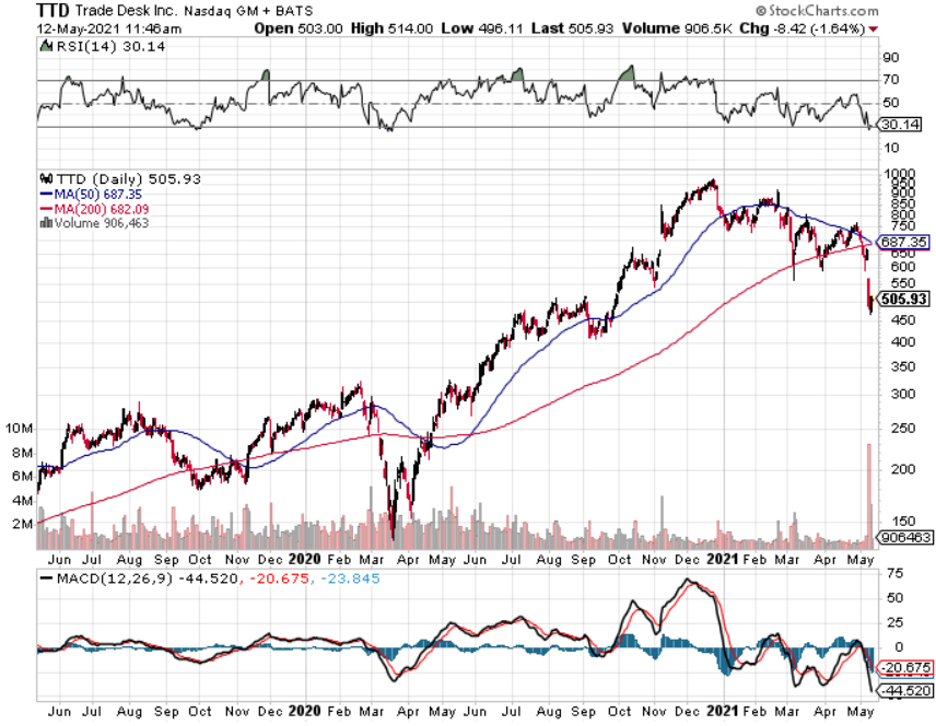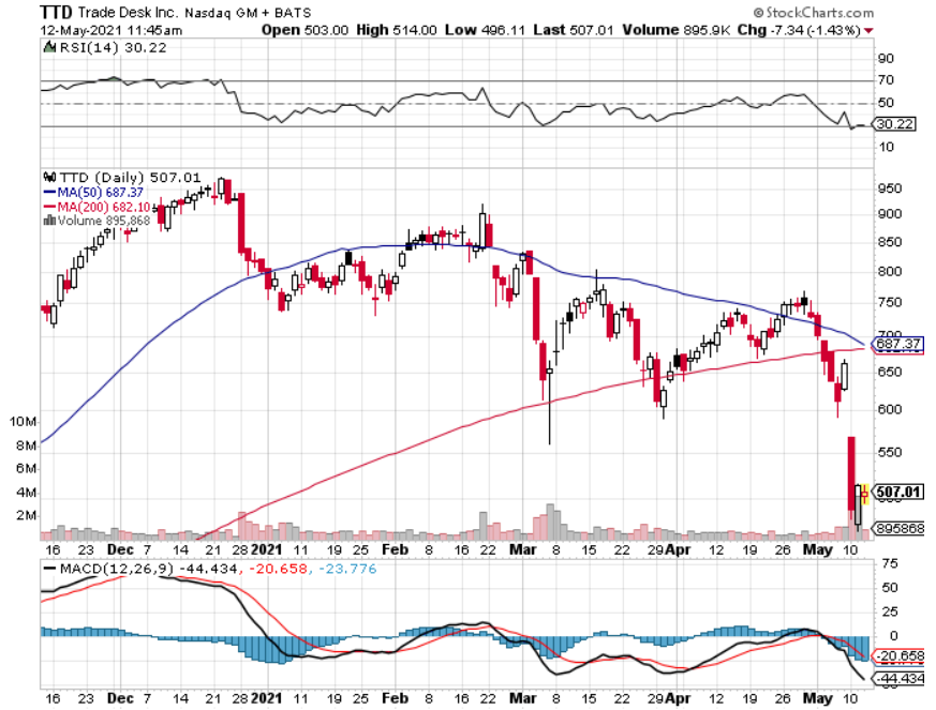Annual advertising budgets are often being reset and reconsidered in Q1, but as the economy is roaring back, digital ad deliverers are set to make hay.
The Trade Desk (TTD) specializes in programmatic ad buying.
What is it?
It’s the deployment of software to buy digital advertising.
Previously, the traditional way included requests for proposals, tenders, quotes, and human negotiation, but programmatic buying uses machines and algorithms to purchase display space.
Humans now have more time for the optimization and evolution of ads.
Ad agencies will always need to optimize advertising to meet consumers’ needs on a deeper level.
Programmatic-centric software will deliver a better set of tools to plan, optimize and target advertising effectively.
Since TTD doesn’t make anything physical, margins are usually a lot higher and that certainly showed with Q1 producing adjusted EBITDA of a record $70.5 million.
This Q1 record is on both an absolute basis and a percentage of revenue basis.
As TTD continues to grow and represent more large brands and a larger percentage of ad agencies' brands, they will continue to become an accurate bellwether for the open Internet and advertising spend.
When you consider their performance in the context of the health of the overall advertising industry, you can see how they continue to outperform the industry and gain market share.
WPP's GroupM predicts worldwide advertising revenue will increase 10% in 2021. Publicis Groupe's Zenith expects overall U.S. ad spending to rise 3.2% in 2021, following a drop of 5.4% last year. GroupM also predicts digital advertising will surge 14% to nearly $400 billion.
Almost all major content owners put more premium inventory online.
Today, TV providers are fighting for consumer attention and there is more competition than ever.
The gap in cost-adjusted efficacy between linear and Connected TV (CTV) has stayed strong. However, as advertisers embrace CTV to leverage data and relevance, the power of data-driven targeting is quickly becoming more apparent.
Only effective data-driven targeting can achieve the value sought after by advertisers.
In other words, TV advertisers now have a choice. They have the ability to differentiate between content across channels more than ever. And that's critical to a healthy and competitive CTV market.
Now just to put the CTV market scale in perspective, according to Omdia's latest research, there are now more than 200 million active Advertising-Based Video on Demand (AVOD) users in the U.S. alone.
By 2024, Omdia predicts that annual CTV advertising revenue will top $120 billion, outperforming subscription revenue by more than 20%.
More and more of the world's top advertisers are making programmatic buys a larger component of their upfront commitments.
Advertisers want more data-driven flexibility in TV advertising campaigns. They believe their digital buys should be a core element of their upfront commitment. And the networks are adapting to that demand.
Ultimately, this will lead to the development of a new programmatic forward market for CTV inventory.
Broadcasters are also applying the same innovation focus to the world of identity. Recently, TTD has announced collaborations with OpenAP and Blockgraph.
This discussion on identity is bigger than cookies. It's bigger than any company or any channel. Cookies are not present in CTV. However, a privacy-safe identifier for CTV will be a major factor in driving relevant ads and managing reach and frequency across apps, channels, and devices.
CTV needs this kind of approach in order to maintain pricing power in a way that helps fund the high quality content that has kept most consumers binge-watching during this pandemic.
The current TV content arms race cannot be financially sustained for providers or consumers without relevant ads.
UID or user ID number is the identification number of your user account.
Remember how UID works, consumers sign in once with their email address and then opt-in site by site, just once per site or app, or channel.
This is a significant improvement to the consumer Internet experience today, where intrusive toasts or cookie pop-ups appear on almost every premium content site and seemingly every time you go there.
It's a common ID that can be used by many different advertisers and publishers.
It often originates from publishers with existing sign-on systems.
Consumers can then engage with privacy settings and opt out directly from the services they know.
The Wall Street Journal reported 50 million UID authenticated users in the U.S. a couple of months ago.
There's no point in building walls around it. Brands will, over time, always gravitate to places where they can be deliberate and where they can measure ad impressions across channels.
There are some companies, mostly those with a dominant walled garden approach, that believe the Internet can be controlled by a few.
Then there's the rest who believe that an open, competitive Internet marketplace is the only real viable approach that preserves value and opportunity for all participants.
And that has meant that cord-cutting in linear or cable television has accelerated and that people are looking more and more at Internet-fueled TV.
Because there are also more apps than there have ever been, content discovery is tougher in CTV than it’s ever been.
TTD’s Q1 revenue was $220 million, a 37% increase from a year ago and TTD benefited from improvement in the digital advertising environment from both agencies and brands.
Video, which includes CTV, again, led growth during the quarter followed by audio.
While improving, the travel and entertainment verticals still lag compared to others, but both are showing signs of a rebound so far in Q2. There is still a massive recovery ahead in these segments and starting to see green shoots.
TTD estimates Q2 revenue to be between $259 million and $262 million, which would represent growth of between 86% to 88% on a year-over-year basis because Q2 last year was the nadir of TTD’s Covid problems to the ad buying industry.
That said, in the second half of 2021, TTD expects year-over-year total revenue growth rates to decelerate significantly on a sequential basis because comparable data will be hard to beat from Q3 and Q4.
This was the cue for a massive selloff in TTD shares.
Don’t forget that the 2020 U.S. Election produced a tsunami of ad buying in the 2nd half of 2020.
The company is still firing on all cylinders, justifying the move from $160 in March 2020 to $950, but price action in shares is volatile.
The stock has pulled back to around $500 and has technical support at $450, I would look for an entry point around there if the broader market calms down.



